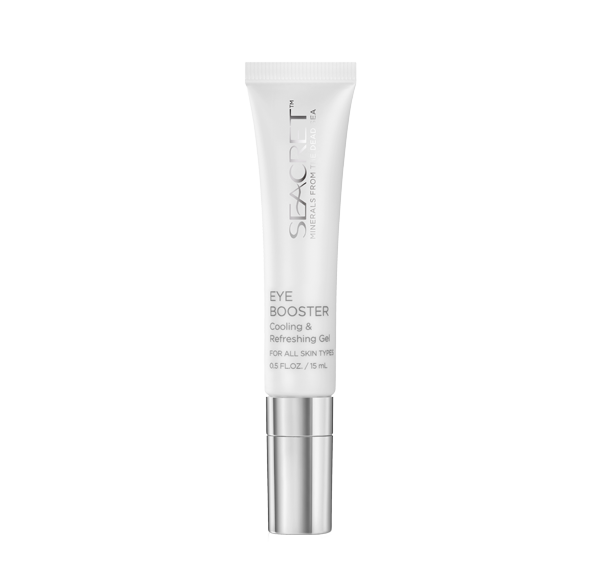Seacret Eye Booster Review
ABOUT SEACRET EYE BOOSTER
Seacert Eye Booster is a ceramic applicator that cools and refreshes, while the moisture-rich gel composition helps to smooth the delicate skin around the eyes, reduce puffiness, and diminish dark circles for a more youthful appearance.
Seacret Eye Booster is formulated with premium ingredients to provide your eyes with hydration and a youthful glow.
SEACRET EYE BOOSTER BENEFITS
- Provides a cooling and refreshing effect.
- Addresses the look of fine lines, wrinkles, puffiness and dark circles.
- Create a firmer look around the sensitive eye area.
SEACRET EYE BOOSTER INGREDIENTS
KEY INGREDIENTS:
- Dead Sea Minerals
- Vitamin C
- Hydrogel
- Hyaluronic Acid
- Vectorized Caffeine
- Chamomile
SEACRET EYE BOOSTER INGREDIENTS RESEARCH
DEAD SEA MINERALS RESEARCH
Dead Sea Minerals contain minerals that can counteract apparent indications of aging skin, such as fine lines and uneven skin tone, to improve overall skin appearance. Not only does Dead Sea salt moisturize the skin, but it also exfoliates dead skin cells, allowing new skin cells to develop (1).
A 5% Dead Sea salt solution enhances skin hydration, reduces redness and roughness, and strengthens the skin barrier, according to a 2005 study.
The Dead Sea is known as nature’s spring of youth. Minerals found in Dead Sea salt, such as silica, zinc, and calcium, boost the vitality of your skin and slow the aging process. The minerals help battle oxidation in skin cells by eliminating free radicals, making your skin appear younger and more vibrant.
Another study, revealed that Dead Sea minerals exhibited skin smoothing capabilities in a study on skin roughness. They discovered that when compared to a placebo and a commercially prepared anti-wrinkle gel, a Dead Sea mineral solution reduced skin roughness by more than 40% on average.
VITAMIN C RESEARCH
A few clinical studies have shown that vitamin C can reduce the appearance of creases. One study found that daily use of a vitamin C formulation for at least three months enhanced the appearance of fine and coarse facial and neck wrinkles, as well as the texture and appearance of the skin as a whole (2).
When combined with a broad-spectrum sunscreen, vitamin C may also help protect the epidermis from harmful ultraviolet rays. Clinical studies have demonstrated that combining vitamin C with other topical ingredients, such as ferulic acid and vitamin E, can reduce redness and protect the skin from long-term sun injury (3, 4).
HYALURONIC ACID RESEARCH
Skin aging is associated with loss of moisture in the skin.
Hyaluronic acid (HA) is the main molecule involved in skin moisture because of its unique ability to bind and retain water molecules (5). Hyaluronic Acid retains water in the skin barrier to improve plumpness and reduce fine lines and wrinkles (5).
“HA is a humectant — a substance that retains moisture — and it is capable of binding over one thousand times its weight in water.”
Since HA can hold over 1000 times it weight it water it makes HA one of the best ingredients for restoring moisture content to skin as well as smoothing out the skin by restoring hydration to the skin barrier (6).
CHAMOMILE RESEARCH
“Chamomile has astringent and brightening properties that, in addition to tightening pores and softening the skin, can fade acne scars and hyperpigmentation when used regularly.”
Chamomile for skin can be used as a mild astringent, which causes body tissue to contract. It gently kills bacteria, helps fade hyperpigmentation or red spots, and speeds up cell regeneration, which aids in the clearing of the skin.
Antioxidants combat oxidative stress caused by free radicals, which occur naturally as a result of metabolic processes and inflammation. Fine lines, wrinkles, hyperpigmentation, and other indications of aging have all been related to oxidative stress (8).
Chamomile for skin includes anti-oxidants such as polyphenols and phytochemicals. It may help minimize signs of aging by shielding the skin from free radical damage when administered to the skin (9).
“It accelerates cell and tissue renewal, reducing the appearance of fine lines and giving skin a youthful glow,” adds Engelman.
Work Cited :
- Baek J, et al. (2016). Oxidative stress and antioxidant strategies in dermatology.
tandfonline.com/doi/full/10.1179/1351000215Y.0000000015 - Buckle J. (2015). Basic plant taxonomy, basic essential oil chemistry, extraction, biosynthesis, and analysis.
coek.info/pdf-basic-plant-taxonomy-chemistry-extraction-biosynthesis-and-analysis-.html - Kazemian H, et al. (2018). In vivo antibacterial and wound healing activities of Roman Cchamomile (Chamaemelum nobile).
eurekaselect.com/148825/article - Learn the language of skin care labels. (2017).
aad.org/news/product-labels - Lee SH, et al. (2010). Effect of German chamomile oil application on alleviating atopic dermatitis-like immune alterations in mice.
ncbi.nlm.nih.gov/pmc/articles/PMC2833428/ - Lin TK, et al. (2017). Anti-inflammatory and skin barrier repair effects of topical application of some plant oils.
ncbi.nlm.nih.gov/pmc/articles/PMC5796020/ - Miraj S, et al. (2016). A systematic review study of therapeutic effects of Matricaria recuitta chamomile (chamomile).
ncbi.nlm.nih.gov/pmc/articles/PMC5074766/ - Stallings AF, et al. (2009). Practical uses of botanicals in skin care.
ncbi.nlm.nih.gov/pmc/articles/PMC2958188/ - Srivastava JK, et al. (2011.). Chamomile: A herbal medicine of the past with bright future.
ncbi.nlm.nih.gov/pmc/articles/PMC2995283/


